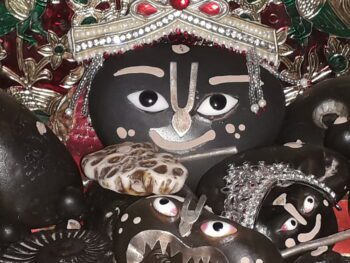
Vishnu Ashtottara Shatanamavali (Vishnu 108 Names Recital)
Vishnu Ashtottara Shatanamavali (Vishnu 108 Names Recital) contains : Ganapathi Pushpanjali then recital of 108 Mantras with Pushpanjali, Tulsi ,Shanti Mantras,Mantra Pushpam.

Vishnu Ashtottara Shatanamavali (Vishnu 108 Names Recital) contains : Ganapathi Pushpanjali then recital of 108 Mantras with Pushpanjali, Tulsi ,Shanti Mantras,Mantra Pushpam.
The various names in Vishnu ashtottara shatanamavali originate from its various avatars. Vishnu is one of the most important deities of Hinduism and the absolute deity of Vaishnavism. Vishnu, one of the three deities, is also the protector of the three worlds. The word Vishnu means omnipresent. According to Vaishnavism, Lord Vishnu is said to take various incarnations to establish Dharma when Adharma rises in the world. Accordingly, the incarnations of Rama and Krishna are notable among the Dasha avataras he took.Vishnu is known by many names like Narayanan, Vasudevan, Jagannath, Hari, Thirumal. He is seen with blue skin on his lower right hand holding Gada, lower left hand holding the Padma, upper right hand holding Sudarshan, and upper left hand wearing Panchajanya. He is also believed to be with Goddess Lakshmi in the Milky Way on a serpent bed called Ananta. Veda Vyasa states that when Vishnu performs Shiva Puja and tries to achieve the Sudarshana Chakra, he adorned his eyes with a flower and finally got the Sudarshana Chakra. Garuda is considered as his vehicle and Shalagram is considered as his invisible form. He is the only deity in the Hindu temples who is the source of the Sayanak Kolam. The epics Mahabharata describes his Krishna incarnation and Ramayana his Rama incarnation. Twelve Puranas, including the Bhagavat Purana, the Ari Vamsha, the Vishnu Purana, the Macha Purana, and the Vamana Purana, describe the glories of Vishnu.
The four qualities of Vishnu include,
Vatsalyam – The calf love of the mother cow.Ownership – The specialty of leading all the gods.Flexibility – Appreciating friendship without inequality.Convenience – refers to the simplicity of God.These four qualities are also considered to have manifested in the Krishna incarnation of Vishnu. Regardless of Arjuna’s fault, the performance of the Indian War is said to be eloquent, and Arjuna’s explanation of his greatness is eloquent, his friendly admiration for Krishna is polite, and the incarnation of Lord Vishnu as a man is said to be eloquent. Incarnations of Vishnu (Avatars of Vishnu)Vaishnavism considers Vishnu to appear in the world and save the world when Dharma intervenes in the world. For this, the incarnations taken by Vishnu are marked in numbers as Sap Avatharam and Dasavatharam. In the Bhagavata Purana, Vishnu is said to have taken twenty-five incarnations.The incarnations of Vishnu are divided into incarnation, passion, and aspect. Incarnation – with full power.Obsession – becoming powerful only when needed.Feature – A part of Vishnu Shakti is manifested in an image. While Vishnu and Lakshmi were alone in the ocean, some sage (good people) came to see Vishnu. They were stopped by two gatekeepers, Jaya and Vijaya. The sages, enraged at being prevented from coming to the vision of the Lord, cursed the gatekeepers to be born as cruel monsters. Knowing this, Vishnu is said to have taken Dashavatara to subdue his gatekeepers when they were born as demons.
The ten incarnations are said to be:First Incarnation Matsya,Second Incarnation Buddha,Third Incarnation Varaha, Fourth Incarnation Narasimha, Fifth incarnation Vamana Sixth incarnation Parashurama Seventh Incarnation Rama, Eighth Incarnation Balarama, Ninth Incarnation Krishna, Tenth incarnation Kalki
Gautama Buddha, the founder of Buddhism, is also considered to be one of the Dashavatar of Vishnu. Goddess Mohini is also considered to be one of the incarnations of Lord Vishnu who seduced the asuras while crossing the Tirupati sea. There are messages about this in the Puranas as well. Also, an inscription on the top of the Ariyaran sculpture at Mahabalipuram has the following North language slogan about Dasavatharam. Vishnu is said to be the brother of Goddess Parvati, the Hindu god, and wife of Lord Shiva. Valli and Devayani, who emerged from the tears of Vishnu, were married to Lord Shiva by Lord Shiva-Parvati and became the son-in-law of Lord Vishnu. And Brahma created God from his navel and became his father designed by Lord Shiva Pitsadana to suppress the arrogance of the Rishis in Darukavanam
Description About the names from Ancient texts and its History
The section called Vishnu Sahasranama is a chapter in the Mahabharata containing the names of a thousand Vishnu taught to Yudhisthira on the battlefield of Bhishma. This is the 149th chapter of the Mahabharata Anusasanika Parvat. ‘Sahasram’ means a thousand. The Sahasranama section alone contains 107 verses in the vernacular form of ‘Anushtup’ and about 40 verses before and after them. It is still revered as a masterpiece in ancient Hindu scriptures Names were Compiled by Vyasadev. Hinduism owes much to Vyasa, who composed the Mahabharata, and the 18 Puranas and 18 sub-Puranas. Because he has suppressed many rare great psalms in every book he has written. Similarly, the Vishnu Sahasranama is included as a chapter in the Mahabharata.
Vishnu Sahasranama Olaichuvadi, AD 1690
This is a psalm for sattva worship taught to the sattva-minded Yudhisthira by the sattva-possessed Bhishma. Bhagavad-gita, which lists twelve people who know everything about Dharma in the world, [1] adds Bishmar’s spiritual pride to that list. That is why when Yudhisthira asks Kannan about the ripples of Dharma after the Mahabharata war, Kannan takes him to Bhishma and says, ‘Come, let us hear this from Bhishma. In order to dispel the doubts of Yudhisthira, Bhishma preached royal dharma, crisis dharma, male and female dharma, dhana dharma, house dharma, and many more. The ‘commandment’ is that which our forefathers lovingly commanded us to follow in the footsteps of those who have explored and realized that it is the right path. At the end of the Anusasanaparvam, which is full of such precepts, the Vishnu Sahasranama becomes an excellent injunction. Finally, Yudhisthira asks six questions:
Which is the best deity mentioned in all the scriptures describing God?
What is the highest level to achieve it?
Which deity will be healed by praising lord’s attributes?
Which deity should be worshiped outside or by the mind and soul?
The only definitive answer to all these questions is that Bhishma recites the Sahasranama of Vishnu, saying that one who meditates, praises, and worships the names of Vishnu Ashtottara Shatanamavali will overcome all sorrows. The tongue that utters them and worships him will be free of sorrows.The chanting with 1008 names in the Sahasranama is an glorification of the Lord’s ‘infinite-qualities’, that is, His infinitely virtuous nature. Every name shows the virtue of something. Some names are names that may or may not appear because of their nature. To understand the full meaning of these names, we may need to know some of the theological nuances that came through some hereditary way.
Chapter 2 Verse 27 page 5 says, O Maitreya! In the Holocaust period, when the prime is situated in the equable state of nature, ie, when the man is situated separately from nature, the Kaal form of Lord Vishnu changes.
Chapter 2 verses 28 to 30 Page 5, Subsequently (in the presence of the Sarga period), the Supreme God, the Supreme God, the omnipotent Sarva Bhuteshwar Sarvatma Parmeshwar, by his will entered into the vicious head and the imperishable man. In the same way, even if it is not functional, the smell affects the head and the male by its sensory quantity.
In verses 28 to 30, it is clarified that there is some other God from Prakriti (Durga) and Purush (Kaal-Prabhu) who inspires both of them to re-create creation.
Chapter 2 is written in verse 66 on page 8 that they are the ones who create their own creation by becoming Lord Vishnu (Brahma). Verse 70 is written. Lord Vishnu is the one who creates Brahma etc. through stages. They are created and they themselves also die, i.e. codified.
Chapter 4 Verse 4 says on page 11 that there is some other god who is also the God of Brahma, Shiva, and other gods.
Chapter 4 Verse 14.15, 17, 22 is written on pages 11, 12. Prithvi spoke – O Kaal Swaroop! Hello to you Oh, Lord! You of the world Brahma, Vishnu, and Rudra are supposed to take the form for creation, etc.Your form which appears in an avatar form is worshiped by the gods. You are the only one Chapter 4 Verse 50 is written on page 14 – Then those are God, the Hindu scripture is the Vedas. Upanishads are considered to be the core of the Vedas and the Gita core of the Upanishads. Other texts are texts of history, tradition, and ritual. Purana means the most ancient. Most ancient. History texts include Valmiki Ramayana, Vedas Mahabharat, and Purana.
Let’s know about the 18 Puranas of Vishnu
Purana has been composed by Parashar Rishi, grandson of Maharishi Vasishta, and father of Ved Vyasa. Purana gives a description of Lord Vishnu and his devotees, which contains very interesting stories.A description of the incarnations of Vishnu will be found in this Purana, in which there is special mention of Shri Krishna Charitra and Ram Katha.This Purana has six chapters. The first has interesting tales of Dhruva, Prithu, and Prahalad, along with the origin and nature of time. In the second, you will find the description of all the worlds and the nine sections of the earth as well as the description of the planets and constellations.In the third, descriptions of the Manvantara period, expansion of Vedas, household religion and Sharad-Vidhi, etc. will be found.The fourth describes the king of the Surya dynasty and the Chandra dynasty and their lineages. The fifth describes Sri Krishna’s character and his pastimes. Finally, in the sixth chapter, knowledge of the holocaust and salvation will be found.
The names have a long history and are of utmost importance to Hindus. The history, the stories and the books imply major significance of Vishnu in the Hindu Dharma. Chanting these names will give humans peace, health and the gift of intelligence.
